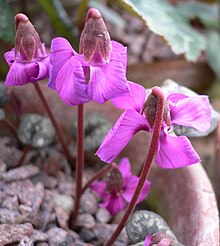Cyclamen alpinum
| Cyclamen alpinum | |
|---|---|

| |
| Cyclamen alpinum | |
| Scientific classification | |
| Kingdom: | |
| (unranked): | |
| (unranked): | |
| (unranked): | |
| Order: | |
| Family: | |
| Genus: | |
| Subgenus: | Gyrophoebe
|
| Series: | Pubipedia
|
| Binomial name | |
| Cyclamen alpinum Dammann ex. Springer
| |
| Synonyms | |
|
Cyclamen trochopteranthum Template:O. Schwarz | |
Cyclamen alpinum (= Cyclamen trochopteranthum) is a perennial growing from a tuber, native to pine, juniper, sweetgum, or cedar woodland at 350–1,500 m (1,150–4,920 ft) above sea level in an area of southwestern Turkey, northwest of Antalya, isolated from other species of the Cyclamen coum group.
Name
The alternate species name trochopteranthum comes from Greek trochós "wheel" and pterón "feather", "wing", probably meaning "propeller" and ánthos "flower".[1]
The scientific name Cyclamen alpinum has been applied to three other species as well: Cyclamen coum, Cyclamen cilicium, and Cyclamen intaminatum (as a variety of C. cilicium).
Description
Leaves are oval to round, green and often variegated with silver above (unlike the similar species Cyclamen parviflorum, which is entirely green) and red-purple below.
Flowers have 5 petals, pale rose-pink to pink-carmine or white with a dark magenta spot at the nose, spreading rather than fully upswept and often twisted like the blades of a propeller, as in Cyclamen parviflorum var. subalpinum.
Forms
Cyclamen alpinum forma leucanthum (= Cyclamen alpinum forma album) has white petals.
References
External links
- Cyclamen Society — 1997 expedition (Cyclamen trochopteranthum)
- Paghat's Garden (Cyclamen trochopteranthum)
- Pacific Bulb Society (Cyclamen trochopteranthum)
- "Cyclamen alpinum". Germplasm Resources Information Network. Agricultural Research Service, United States Department of Agriculture.
- photos — wild plants
- photos — Jearrard's Herbal
- photo — TrekNature
- photo — South Wales Alpine Garden Society Show
